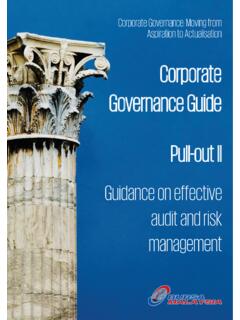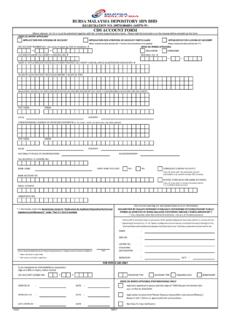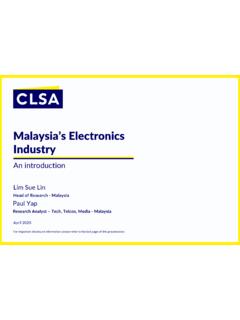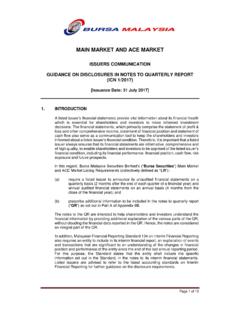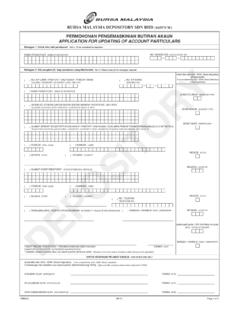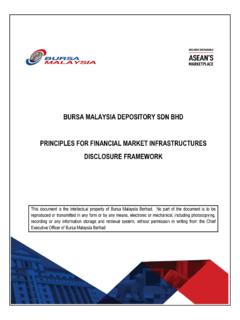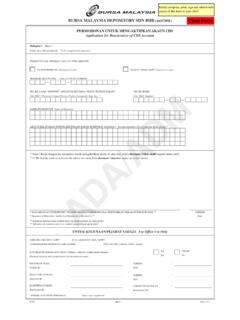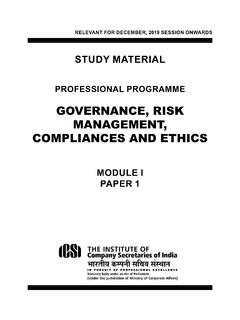Transcription of Corporate Governance Guide - Bursa Malaysia
1 Corporate Governance : Moving from Aspiration to Actualisation Pull-out I Guidance on board leadership and effectiveness Corporate Governance Guide Corporate Governance Guide Pull-out I Contents Introduction 1 Background 1 Section I : Board leadership 2 Section II : Board dynamics 8 Section III : Nominating committee 11 Section IV: Remuneration committee 13 Practices and Step Ups 15 Board responsibilities Practice 16 Practice 27 Practice 34 Practice 39 Practice 46 Practice 55 Practice 62 Practice 70 Board composition Practice 77 Practices and Step up 82 Practices and 91 Practice 101 Practice 108 Practice 113 Remuneration Practice 126 Practice 137 Practice , and Step up 143 Appendices 153 Appendix I : Whistleblowing policy 154 Appendix II : Board skills matrix form 158 Appendix III : Board and board committee evaluation form 160 Appendix IV: Directors /key officers evaluation form 169 Appendix V : Audit committee (AC) evaluation form 174 Appendix VI: Audit committee members self and peer evaluation form 181 Corporate Governance Guide Pull-out II 1 Introduction Background This Introduction to Pull-out I ( Board leadership and effectiveness ) is designed to provide boards with broad guidance in promoting the application of good Corporate Governance within the company.
2 The Introduction also intends to provide boards with direction in implementing the Practices and the Step Ups of Principle A in the Malaysian Code on Corporate Governance and thus, should be read in conjunction with the write-ups on the individual Practices and Step Ups encapsulated in this Pull-out. For about 2,000 years, man thought of earth as the centre of the universe. Indeed, this was most famously postulated by Aristotle and became the accepted wisdom until after the end of the Middle Ages, when Galileo s observation dismantled the truth and disproved what was almost universally thought to be correct. Framers and thought leaders of Corporate Governance alike have always intended the board of directors to be the centre of the company s universe , as it were, but unlike Aristotle s theory, this model still holds true. It is widely accepted that a company s Corporate Governance begins and ends with its board of directors.
3 The board has the power to shape the company s direction and culture through its Corporate Governance philosophy and practices. In addition, as strange as it might sound, the board also influences the company s Corporate Governance through its inaction, albeit in a negative way, leaving a vacuum that management and employees will fill. An effective board does not place itself in a comfortable setting and it does not remain static. As with all living organisms, the board being a body of individuals should constantly evolve in response to the environment in which it operates. Challenge as well as teamwork are essential features of the board. Diversity in board composition is an important driver of a board s effectiveness, creating a breadth of perspective among directors. Whilst the importance of constituting a board optimal for the company s size and complexity is well understood, less appreciated is the need for the board to perform at the levels expected of it.
4 Indeed, in the oft-cited story of Enron Corporation, its board was composed of eminent individuals who were all highly experienced and qualified. However, the board failed to discharge its duties adequately, ultimately leading to the company s demise. It is vital that board members see their directorships as a journey of stewardship rather than a position of privilege. The notion of stewardship points that directors have a responsibility not only to themselves but to the company, its shareholders and the wider group of stakeholders as well. Having said that, it is also important to iterate that good Corporate Governance is not against self-enrichment, as this is a key driver in a free economy. Rather, good Corporate Governance calls for directors to walk down this path of enrichment in an ethical and sustainable manner. This Introduction is set out over four sections.
5 Section I addresses board leadership whilst Section II explores board dynamics. Section III sheds light on the nominating committee and lastly, Section IV discusses on the remuneration committee. Corporate Governance Guide Pull-out II 2 Board leadership Understanding board s responsibilities In framing the responsibilities of the board in leading the company, Guidance to Practice of MCCG makes a noteworthy statement. The term amongst others is used when outlining the roles and responsibilities of the board. This indicates that the board should not treat the responsibilities narrated in this MCCG as definitive and exhaustive. This approach recognises that companies are unique entities with their own circumstances and rigid prescriptions do not work. Considerations on the responsibilities of the board are covered in detail in the write-up to Practice In discharging their responsibilities, directors must fulfill their duty of care, skill and diligence in a conscientious manner.
6 The following guidance may be helpful to directors: ensure that the company has established an effective Governance system and process; refrain from rushing into decision-making. Provide adequate time for deliberations and evaluations of transactional and financial matters; require sufficient notice and distribution of board papers and explanatory appendices in advance of meetings; make informed decisions based on the information and recommendations of the company s independent professional advisors; ensure that there is no undue pressure from dominant personalities or nominees of Large Shareholders1; ensure proper record of key decision-making deliberations; base reliance on others where there is a sound basis for doing so; and take additional advice, independent from management if they feel it necessary. Boards bear the ultimate responsibility for their company s values and actions.
7 There is no single boardroom style that applies to all boards and what works for one board may not necessarily work for another. The style and approach of the board in the same company may also vary over time as circumstances change. Nevertheless, the following observations can be made: Boards impacted by personal conflicts rarely work well. Honest, open debate may be inhibited and personal agendas may be allowed to override a director s responsibility to shareholders; The chairman and chief executive officer play a key role in setting the board s approach; Good boards exhibit a degree of healthy skepticism. Differences are not suppressed, and issues are argued out with logic and passion. Differing opinions are respected and individual contributions encouraged. However, there is an underlying harmony driven by a collective understanding of the board s stewardship; External advisors should be used to enhance both board s and management s understanding of particular or emerging issues; and Good boards have the courage to make difficult decisions.
8 Individuals stick by these collective decisions, even when they may have personally opposed them. 1 As stated in Guidance to Practice of MCCG, Large Shareholder means a person who is entitled to exercise, or control the exercise of, not less than 33% of the voting shares in the company; is the largest shareholder of voting shares in the company; has the power to appoint or cause to be appointed a majority of the directors of the company; or has the power to make or cause to be made, decisions in respect of the business or administration of the company, and to give effect to such decisions or cause them to be given effect to. Section I Corporate Governance Guide Pull-out II 3 Directors of a company, executive or non-executive, have an obligation to exercise unfettered judgement, in good faith with due care and skill.
9 A director must be aware of the legal parameters that defines the duties in law. A director owes fiduciary duties similar in some respects of those of a trustee. The diagram below illustrates the core duties of a director: The primarily responsibilities and duties of the board in this regard are well contained in Section 213 of Companies Act 2016. Section 213 of Companies Act 2016 Duties and responsibilities of directors 1. A director of a company shall at all times exercise his powers in accordance with this Act, for a proper purpose and in good faith in the best interest of the company. 2. A director of a company shall exercise reasonable care, skill and diligence with- a) the knowledge, skill and experience which may reasonably be expected of a director having the same responsibilities: and b) any additional knowledge, skill and experience which the director in fact has.
10 3. A director who contravenes this section commits an offence and shall, on conviction, be liable to imprisonment for a term not exceeding five years or a fine not exceeding three million ringgit or both. Note: The above only represents an extract of the duties and responsibilities of directors. Board s role in setting strategy It is commonly observed that for some companies, the board is content to set the strategy at the highest level whilst for other companies, the board s approach is to be involved in strategy setting, even for each subsidiary. In terms of strategy, there is a conscious shift by the MCCG which now calls upon boards to devote the necessary time and effort to set the company s strategy, as opposed to endorsing it. It is acknowledged that some boards have a tendency to outsource strategy setting entirely to management, leaving the board with little or no input on the company s long term direction.
